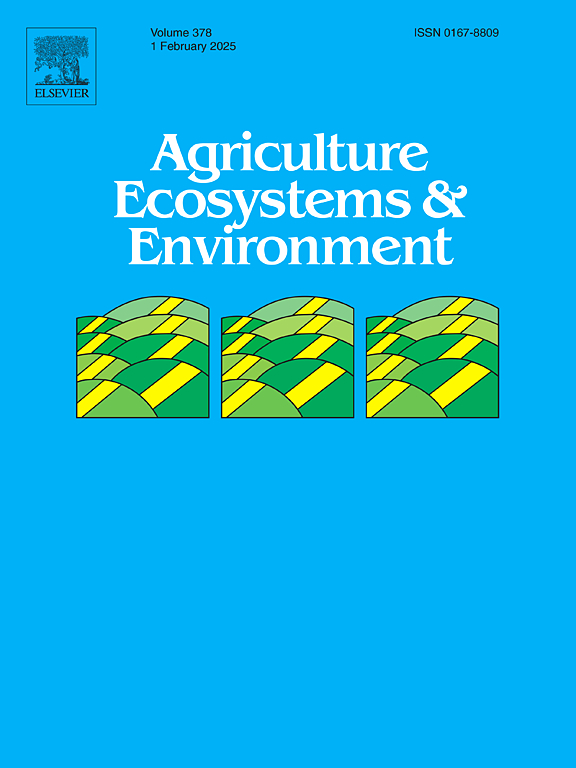非作物生境对西北荒漠绿洲地栖节肢动物多样性的影响
IF 6
1区 农林科学
Q1 AGRICULTURE, MULTIDISCIPLINARY
引用次数: 0
摘要
在农业生态系统中,非作物生境对支持地栖节肢动物多样性起着至关重要的作用。地面节肢动物主要依靠农业景观中的庇护栖息地生存、繁殖和越冬。然而,这些非作物生境在维持沙漠-绿洲生态系统动态方面的具体功能仍未得到充分的了解。本研究以甘肃省河西走廊的新旧绿洲为研究对象。采用陷阱诱捕法,在新旧绿洲的玉米田(MF)、灌溉渠(ID)和林带(FB)中采集了陆生节肢动物。结果表明:(1)新绿洲作物生境与非作物生境地栖节肢动物群落组成差异较大,而旧绿洲地栖节肢动物群落组成差异较小。(2)地栖节肢动物活动密度在中游生境与中游生境间无显著差异。但7月份活性密度显著高于FB (P <; 0.05)。(3) 4月和10月,捕食性昆虫的活动密度与此基本一致,但草食性昆虫在ID和FB生境的活动密度均大于MF生境。(4)地上生物量(AGB)、土壤容重(SBD)和总氮(TN)占新绿洲地栖节肢动物群落变异的14.9 %;AGB、SBD和土壤有机碳(SOC)占老绿洲地栖节肢动物群落变化的7.8% %。总体而言,非作物生境对维持地栖节肢动物多样性至关重要。非作物生境通过支持有助于有效调节农田景观的季节性迁徙过程,加强了沙漠农业生态系统内生物多样性的保护和管理。本文章由计算机程序翻译,如有差异,请以英文原文为准。
Effects of non-crop habitats on ground-dwelling arthropod diversity in a desert-oasis region of northwest China
Non-crop habitats play a vital role in supporting ground-dwelling arthropod diversity in the agriculture ecosystems. Ground-dwelling arthropods predominantly depend on shelter habitats within agricultural landscapes for survival, reproduction, and overwintering. Nevertheless, the specific functions of these non-crop habitats in maintaining desert-oasis ecosystem dynamics remain insufficiently understood. This study was conducted in the new and old oasis, located in the Hexi Corridor of Gansu Province. Ground-dwelling arthropods were collected using pitfall trapping from maize fields (MF), irrigation ditches (ID), and forest belts (FB) of the new and old oasis. The results indicated that: (1) Community composition of ground-dwelling arthropods varied substantially between crop and non-crop habitats in the new oasis, whereas the distinction was less marked in the old oasis. (2) There was no significant difference observed in the activity density of ground-dwelling arthropods between MF and ID habitats. However, their activity density significantly higher than in FB during July (P < 0.05). (3) while the activity density of predatory insects follows this general trend, the activity density of herbivorous insects in the ID and FB habitats exceeded that in the MF habitats in both April and October. (4) Aboveground biomass (AGB), soil bulk density (SBD), and total nitrogen (TN) accounted for 14.9 % of the variation of ground-dwelling arthropod community in the new oasis; AGB, SBD, and soil organic carbon (SOC) accounted for 7.8 % of the variation of ground-dwelling arthropod community in the old oasis. Overall, non-crop habitats are essential for maintaining the ground-dwelling arthropod diversity. By supporting seasonal migratory processes that contribute to the effective regulation of farmland landscapes, non-crop habitats enhance biodiversity conservation and management within desert agriculture ecosystems.
求助全文
通过发布文献求助,成功后即可免费获取论文全文。
去求助
来源期刊

Agriculture, Ecosystems & Environment
环境科学-环境科学
CiteScore
11.70
自引率
9.10%
发文量
392
审稿时长
26 days
期刊介绍:
Agriculture, Ecosystems and Environment publishes scientific articles dealing with the interface between agroecosystems and the natural environment, specifically how agriculture influences the environment and how changes in that environment impact agroecosystems. Preference is given to papers from experimental and observational research at the field, system or landscape level, from studies that enhance our understanding of processes using data-based biophysical modelling, and papers that bridge scientific disciplines and integrate knowledge. All papers should be placed in an international or wide comparative context.
 求助内容:
求助内容: 应助结果提醒方式:
应助结果提醒方式:


